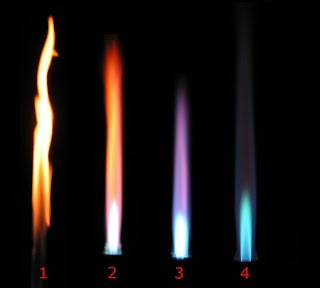 In this picture you'll see the different parts of the bunsen burner (click to enlarge)
In this picture you'll see the different parts of the bunsen burner (click to enlarge)
 In this picture it shows the different types of flames the bunsen burner can create.
In this picture it shows the different types of flames the bunsen burner can create.Of course we also did notes about ACIDS AND BASES
ACIDS
-Solid, liquid, or gas at SATP (standard ambient temp & pressure)
-form conducting aqueous solutions
-dissolve in water to produce H+
-taste sour
BASES
-turn red litmus blue
-slippery
-nonconductive
-dissolve in water to produce OH-
NAMING ACIDS
~acids are aqueous (dissolved in water)
~hydrogen compounds are acids
-HCI(aq)-->Hydrochloric acid
-H(2)SO(4)(aq)-->sulfuric acid
~Hydrogen appears first in the formula unless it is part of a polyatomic group
~CH(3)COOH(aq)-->acetic acid
example HI(aq)--> Hydro Iodic Acid
-classical rules use the suffix IC and/or the prefix HYDRO-
example sulfuric acid
hydrochloric acid
~IUPAC system uses the aqueous hydrogen compound
example HCI(aq)Aqueous hydrogen chloride
NAMING BASES
~for now, all bases will be aqueous solutions of ionic hydroxides
-NaOH
-Ba(OH)2
~use the cation name followed by hydroxide
-sodium hydroxide
-barium hydroxide
these are some examples we went over in class
-H(3)PO(4)(aq) Phosphoric acid
-HNO(3)(aq) Nitric acid
-HNO(aq) Nitrous acid
-Mg(aq) Magnesium hydroxide
-HBr(aq) Hydrobromic acid
-HOOCCOOH(aq) Oxalic acid
We took a break from all the note taking and Mr. Doktor did another experiment :):)
He mixed sulfuric acid with sugar. Here is a video... and you'll see what happens!
Just incase you wanted to see how the bunsen burner worked :)
ps: instead of the striker, we used the stick and match. Just because we're cool.
HOMEWORK: read pages 252-253
do questions 1-9, 28, 34
No comments:
Post a Comment